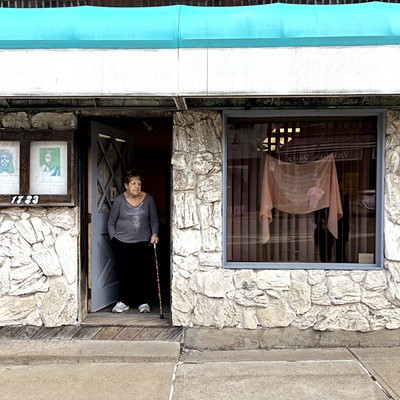Artist Asim Waqif dares viewers to alter his installation, and the world around them
“All that you touch you change. All that you change, changes you.”
Seeing Octavia Butler’s quote — taken from the late sci-fi writer's iconic, post-apocalyptic work Parable of the Sower — etched on a hanging wooden beam as part of artist Asim Waqif's Mattress Factory show Assume the Risk, was grounding, precise, and meta. It directly plays into the show's overall theme, described by the museum as inviting viewers into a "collaborative dynamic and playful installation" that challenges ideas on "authorship and the preciousness of artwork."
That playfulness runs parallel with a more serious commentary about the impact humans have on not only art but every environment they occupy.
Elevator doors open up on the main building’s third floor to orange hazard signs usually reserved for construction work. Hard hats and plastic safety glasses await museumgoers. The phrase “Art you can get into,” stamped across the hard hats, felt fitting.
Museum artworks usually hang behind ropes or sit encased in shiny boxes, but here, that barrier dissolves. A guitar hangs wrapped in twine. Stacks of wood surround you. Bass shakers vibrate the floor beneath your feet. Microphones and speakers activate as you interact. The room buzzes and hums with the movements of every visitor.
Waqif, an India-based sculpture artist, has long been interested in the relationship between people and their environments; built environments contrasted by organically made ones. The title is a declaration that verges on a warning. There’s a physical risk — watch your head as you pass through precarious-looking slanted wood structures and hanging ladders, and your feet as you walk across creaky, uneven platforms. Don’t trip. There’s also a metaphorical risk — risking failure, in what you think you know, or what you consider art. Waqif, who was selected as Mattress Factory's 2021 International Open Call selected artist-in-residence, aims to shutter the gap between viewers and the artwork, allowing them to walk through, add to it, and change it. What Waqif begins, he dares the public to risk finishing, to take it in new directions, to compose and recompose the installation.
The show “becomes a little bit of a living object as you interact with the installation,” exhibitions director Danny Bracken tells Pittsburgh City Paper. It’s true that, in this space, the artwork and its visitors both have a role in what the work becomes. In each moment, the space is changing, with new lighting, different sounds, shifted beams, and new graffiti.
Last September, Waqif visited Pittsburgh to get to know the city and create something in response to what he saw. He later created an artwork based on what he received, scavenged, and discovered. Much time was spent gathering locally sourced raw materials. Waqif found materials at a former flashlight factory, an architectural salvage, and scrap yards. He even used old materials lying around the museum. The museum also made open public calls for donated materials.
In May, Waqif arrived from New Delhi to install the exhibition, which took about six weeks.
Throughout the year-long show run, the space will change as people contribute to the installation. With physical elements added, it’ll be cyclical and iterative.
In the second room, a single spotlight hangs above a spider web of intertwined wood. Aluminum sheets hug wooden beams. Miniature ladders, wooden planks, and sticks are stacked or strewn about on a workstation table, as if giving you a glimpse into Waqif’s process, like he left for coffee, but will be right back to meet with you. These rooms encourage viewers to evolve into artists and collaborators who contribute to the meaning, making, and purpose of the project. It asks them poignant questions: What do viewers offer the space they inhabit? What if they aren’t just spectators but also creators?
Waqif's decision to have viewers aware of their own impact on the museum environment is, in some ways, representative of the current era we’re living through. Unofficially coined as The Anthropocene Epoch, it refers to the most recent period in our geological history, a time when humans have a significant and noticeable impact on the globe’s climate and ecosystems.
In this space, as in the world, there are consequences for your actions. How you consume and how you give will change and shape the room around you. Take the risk. Be willing to change and be changed. Where to start and where to end — there’s no wrong way to explore or experience the exhibition, but do it at your own (willing) risk.
Assume the Risk. Continues through Sept. 1, 2024. 500 Sampsonia Way, North Side. Included with museum admission. mattress.org
Seeing Octavia Butler’s quote — taken from the late sci-fi writer's iconic, post-apocalyptic work Parable of the Sower — etched on a hanging wooden beam as part of artist Asim Waqif's Mattress Factory show Assume the Risk, was grounding, precise, and meta. It directly plays into the show's overall theme, described by the museum as inviting viewers into a "collaborative dynamic and playful installation" that challenges ideas on "authorship and the preciousness of artwork."
That playfulness runs parallel with a more serious commentary about the impact humans have on not only art but every environment they occupy.
Elevator doors open up on the main building’s third floor to orange hazard signs usually reserved for construction work. Hard hats and plastic safety glasses await museumgoers. The phrase “Art you can get into,” stamped across the hard hats, felt fitting.
Museum artworks usually hang behind ropes or sit encased in shiny boxes, but here, that barrier dissolves. A guitar hangs wrapped in twine. Stacks of wood surround you. Bass shakers vibrate the floor beneath your feet. Microphones and speakers activate as you interact. The room buzzes and hums with the movements of every visitor.
Waqif, an India-based sculpture artist, has long been interested in the relationship between people and their environments; built environments contrasted by organically made ones. The title is a declaration that verges on a warning. There’s a physical risk — watch your head as you pass through precarious-looking slanted wood structures and hanging ladders, and your feet as you walk across creaky, uneven platforms. Don’t trip. There’s also a metaphorical risk — risking failure, in what you think you know, or what you consider art. Waqif, who was selected as Mattress Factory's 2021 International Open Call selected artist-in-residence, aims to shutter the gap between viewers and the artwork, allowing them to walk through, add to it, and change it. What Waqif begins, he dares the public to risk finishing, to take it in new directions, to compose and recompose the installation.
The show “becomes a little bit of a living object as you interact with the installation,” exhibitions director Danny Bracken tells Pittsburgh City Paper. It’s true that, in this space, the artwork and its visitors both have a role in what the work becomes. In each moment, the space is changing, with new lighting, different sounds, shifted beams, and new graffiti.
Last September, Waqif visited Pittsburgh to get to know the city and create something in response to what he saw. He later created an artwork based on what he received, scavenged, and discovered. Much time was spent gathering locally sourced raw materials. Waqif found materials at a former flashlight factory, an architectural salvage, and scrap yards. He even used old materials lying around the museum. The museum also made open public calls for donated materials.
In May, Waqif arrived from New Delhi to install the exhibition, which took about six weeks.
Throughout the year-long show run, the space will change as people contribute to the installation. With physical elements added, it’ll be cyclical and iterative.
In the second room, a single spotlight hangs above a spider web of intertwined wood. Aluminum sheets hug wooden beams. Miniature ladders, wooden planks, and sticks are stacked or strewn about on a workstation table, as if giving you a glimpse into Waqif’s process, like he left for coffee, but will be right back to meet with you. These rooms encourage viewers to evolve into artists and collaborators who contribute to the meaning, making, and purpose of the project. It asks them poignant questions: What do viewers offer the space they inhabit? What if they aren’t just spectators but also creators?
Waqif's decision to have viewers aware of their own impact on the museum environment is, in some ways, representative of the current era we’re living through. Unofficially coined as The Anthropocene Epoch, it refers to the most recent period in our geological history, a time when humans have a significant and noticeable impact on the globe’s climate and ecosystems.
In this space, as in the world, there are consequences for your actions. How you consume and how you give will change and shape the room around you. Take the risk. Be willing to change and be changed. Where to start and where to end — there’s no wrong way to explore or experience the exhibition, but do it at your own (willing) risk.
Assume the Risk. Continues through Sept. 1, 2024. 500 Sampsonia Way, North Side. Included with museum admission. mattress.org



















